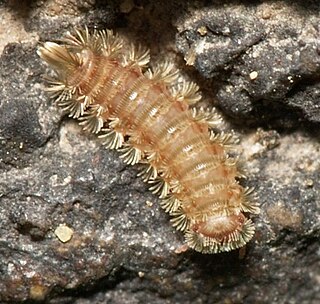 W
WArchipolypoda is an extinct group of millipedes known from fossils in Europe and North America and containing the earliest known land animals. The Archipolypoda was erected by Scudder (1882) but redefined in 2005 with the description of several new species from Scotland. Distinguishing characteristics include relatively large eyes with densely packed ocelli, and modified leg pairs on the 8th body ring. Some species had prominent spines while others had a flattened appearance.
 W
WArthropleuridea is an extinct subclass of myriapod arthropods that flourished during the Carboniferous period, having first arose during the Silurian, and perishing due to climate change just before the Early Permian. Members are characterized by possessing diplosegement paranotal tergal lobes separated from the body axis by a suture, and by sclerotized plates buttressing the leg insertions. Despite their unique features, recent phylogenetic research suggests Arthropleuridea be included among millipedes in the class Diplopoda. The subclass contains three recognized orders, each with a single genus.
 W
WColobognatha is a clade of helminthomorph millipedes containing four orders: Platydesmida, Polyzoniida, Siphonocryptida, and Siphonophorida.
 W
WJuliformia is a taxonomic superorder of millipedes containing three living orders: Julida, Spirobolida, and Spirostreptida, and the extinct group Xyloiuloidea known only from fossils. The species possess long cylindrical bodies with sclerites fused into complete rings. Juliform millipedes possess defensive repugnatorial glands on all body segments except the last few, and are the only known millipedes to produce quinones in their defensive secretions. Juliform males have two pairs of gonopods consisting of the modified 8th and 9th pair of legs: in Julida and Spirobolida the posterior gonopods are primarily involved in sperm-transferring, while in Spirostreptida it is the anterior gonopods. Juliformians also lack Tömösváry organs and have a large collum which overhangs the rear of the head.
 W
WPill millipedes are any members of two living orders of millipedes, often grouped together into a single superorder, Oniscomorpha. The name Oniscomorpha refers to the millipedes' resemblance to certain woodlice (Oniscidea), also called pillbugs or "roly-polies". However, millipedes and woodlice are not closely related ; rather, this is a case of convergent evolution.
 W
WPolyxenida is an order of millipedes readily distinguished by a unique body plan consisting of a soft, non-calcified body ornamented with tufts of bristles – traits that have inspired the common names "bristly millipedes" or "pincushion millipedes". There are at least 86 species in four families worldwide, and are the only living members of the subclass Penicillata.
 W
WPentazonia is a taxonomic infraclass of millipedes containing the pill-millipedes (Oniscomorpha) which can roll into a ball and the order Glomeridesmida which cannot. Defining traits (apomorphies) include divided sternites, a labrum with single median tooth, and an enlarged pygidium on the hind-most body segment. Pentazonia is in the dominant millipede subclass Chilognatha which have a calcified exoskeleton and modified sperm-transferring legs in males. In contrast to the Helminthomorpha – the other Chilognathan infraclass, the sperm-transferring legs are located on posterior body segments and known as telopods. Pentazonians are relatively short-bodied, with between 13 and 21 body segments. The Pentazonia contains one extinct order, Amynilyspedida, often referred to the Oniscomorpha.
 W
WPill millipedes are any members of two living orders of millipedes, often grouped together into a single superorder, Oniscomorpha. The name Oniscomorpha refers to the millipedes' resemblance to certain woodlice (Oniscidea), also called pillbugs or "roly-polies". However, millipedes and woodlice are not closely related ; rather, this is a case of convergent evolution.
 W
WXyloiuloidea is an extinct superfamily of millipedes that existed from the Lower Devonian through the Upper Pennsylvanian period in Europe and North America.